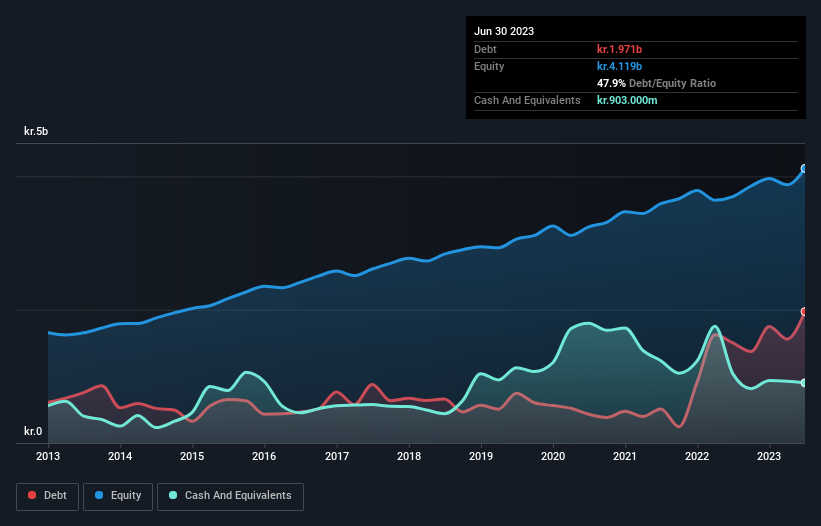- Denmark
- /
- Construction
- /
- CPSE:PAAL B
We Think Per Aarsleff Holding (CPH:PAAL B) Can Stay On Top Of Its Debt

David Iben put it well when he said, 'Volatility is not a risk we care about. What we care about is avoiding the permanent loss of capital.' It's only natural to consider a company's balance sheet when you examine how risky it is, since debt is often involved when a business collapses. We can see that Per Aarsleff Holding A/S (CPH:PAAL B) does use debt in its business. But should shareholders be worried about its use of debt?
When Is Debt A Problem?
Generally speaking, debt only becomes a real problem when a company can't easily pay it off, either by raising capital or with its own cash flow. If things get really bad, the lenders can take control of the business. However, a more frequent (but still costly) occurrence is where a company must issue shares at bargain-basement prices, permanently diluting shareholders, just to shore up its balance sheet. Of course, debt can be an important tool in businesses, particularly capital heavy businesses. When we examine debt levels, we first consider both cash and debt levels, together.
See our latest analysis for Per Aarsleff Holding
What Is Per Aarsleff Holding's Net Debt?
As you can see below, at the end of June 2023, Per Aarsleff Holding had kr.1.97b of debt, up from kr.1.50b a year ago. Click the image for more detail. On the flip side, it has kr.903.0m in cash leading to net debt of about kr.1.07b.

How Healthy Is Per Aarsleff Holding's Balance Sheet?
The latest balance sheet data shows that Per Aarsleff Holding had liabilities of kr.7.05b due within a year, and liabilities of kr.1.18b falling due after that. Offsetting this, it had kr.903.0m in cash and kr.6.31b in receivables that were due within 12 months. So its liabilities total kr.1.02b more than the combination of its cash and short-term receivables.
Of course, Per Aarsleff Holding has a market capitalization of kr.6.29b, so these liabilities are probably manageable. Having said that, it's clear that we should continue to monitor its balance sheet, lest it change for the worse.
We measure a company's debt load relative to its earnings power by looking at its net debt divided by its earnings before interest, tax, depreciation, and amortization (EBITDA) and by calculating how easily its earnings before interest and tax (EBIT) cover its interest expense (interest cover). This way, we consider both the absolute quantum of the debt, as well as the interest rates paid on it.
Per Aarsleff Holding has a low net debt to EBITDA ratio of only 0.69. And its EBIT covers its interest expense a whopping 37.9 times over. So you could argue it is no more threatened by its debt than an elephant is by a mouse. On top of that, Per Aarsleff Holding grew its EBIT by 60% over the last twelve months, and that growth will make it easier to handle its debt. The balance sheet is clearly the area to focus on when you are analysing debt. But ultimately the future profitability of the business will decide if Per Aarsleff Holding can strengthen its balance sheet over time. So if you want to see what the professionals think, you might find this free report on analyst profit forecasts to be interesting.
Finally, a company can only pay off debt with cold hard cash, not accounting profits. So it's worth checking how much of that EBIT is backed by free cash flow. During the last three years, Per Aarsleff Holding burned a lot of cash. While investors are no doubt expecting a reversal of that situation in due course, it clearly does mean its use of debt is more risky.
Our View
Happily, Per Aarsleff Holding's impressive interest cover implies it has the upper hand on its debt. But the stark truth is that we are concerned by its conversion of EBIT to free cash flow. All these things considered, it appears that Per Aarsleff Holding can comfortably handle its current debt levels. Of course, while this leverage can enhance returns on equity, it does bring more risk, so it's worth keeping an eye on this one. There's no doubt that we learn most about debt from the balance sheet. However, not all investment risk resides within the balance sheet - far from it. Case in point: We've spotted 1 warning sign for Per Aarsleff Holding you should be aware of.
When all is said and done, sometimes its easier to focus on companies that don't even need debt. Readers can access a list of growth stocks with zero net debt 100% free, right now.
New: Manage All Your Stock Portfolios in One Place
We've created the ultimate portfolio companion for stock investors, and it's free.
• Connect an unlimited number of Portfolios and see your total in one currency
• Be alerted to new Warning Signs or Risks via email or mobile
• Track the Fair Value of your stocks
Have feedback on this article? Concerned about the content? Get in touch with us directly. Alternatively, email editorial-team (at) simplywallst.com.
This article by Simply Wall St is general in nature. We provide commentary based on historical data and analyst forecasts only using an unbiased methodology and our articles are not intended to be financial advice. It does not constitute a recommendation to buy or sell any stock, and does not take account of your objectives, or your financial situation. We aim to bring you long-term focused analysis driven by fundamental data. Note that our analysis may not factor in the latest price-sensitive company announcements or qualitative material. Simply Wall St has no position in any stocks mentioned.
About CPSE:PAAL B
Per Aarsleff Holding
Provides infrastructure and construction services for societies in Denmark and internationally.
Excellent balance sheet established dividend payer.
Similar Companies
Market Insights
Community Narratives




